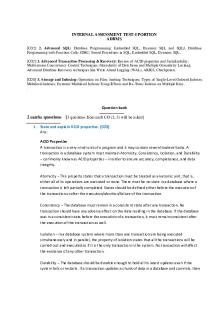T3 Current resistance - Question and solution PDF

| Title | T3 Current resistance - Question and solution |
|---|---|
| Course | Thermodynamics & Heat Transfer |
| Institution | University of Queensland |
| Pages | 12 |
| File Size | 938.9 KB |
| File Type | |
| Total Downloads | 161 |
| Total Views | 374 |
Summary
T3 (MECH3400) Heat Transfer 1) A 12-cm × 18-cm circuit board houses on its surface 100 closely spaced logic chips, each dissipating 0 W in an environment at 40 °C. The heat transfer from the back surface of the board is negligible. If the heat transfer coefficient on the surface of the board is 10 W...
Description
T3 (MECH3400) Heat Transfer 1) A 12-cm × 18-cm circuit board houses on its surface 100 closely spaced logic chips, each dissipating 0.06 W in an environment at 40 °C. The heat transfer from the back surface of the board is negligible. If the heat transfer coefficient on the surface of the board is 10 W/(m2 K), determine ( ) the heat flux on the surface of the circuit board, in W/m2 ; ( ) the surface temperature of the chips; and ( ) the thermal resistance between the surface of the circuit board and the cooling medium, in °C/W. (Ans: ( ) 278 W/ m2 , ( ) 67.8 °C, ( ) 4.63 °C/W)
2) Water is boiling in a 25-cm-diameter aluminium pan ( = 237 w/m.K) at 95 °C. Heat is transferred steadily to the boiling water in the pan through its 0.5-cm-thick flat bottom at a rate of 800 W. If the inner surface temperature of the bottom of the pan is 108 °C, determine ( ) the boiling heat transfer coefficient on the inner surface of the pan and ( ) the outer surface temperature of the bottom of the pan. (Ans: ( ) 1254 W/m2 . °C, ( ) 108.3 °C)
3) Clothing made of several thin layers of fabric with trapped air in between, often called ski clothing, is commonly used in cold climates because it is light, fashionable, and a very effective thermal insulator. So, it is no surprise that such clothing has largely replaced thick and heavy old-fashioned coats.
T3 (MECH3400) Consider a jacket made of five layers of 0.1-mm-thick synthetic fabric ( = 0.13 W/m.K) with 1.5-mm-thick air space ( = 0.026 W/m.K) between the layers. Assuming the inner surface temperature of the jacket to be 28 °C and the surface area to be 1.25 m2, determine the rate of heat loss through the jacket when the temperature of the outdoors is 0 °C and the heat transfer coefficient at the outer surface is 25 W/ m2.K. (Ans: 127 W) What would your response be if the jacket is made of a single layer of 0.5-mm-thick synthetic fabric? What should be the thickness of a wool fabric ( = 0.035 W/m.K) if the person is to achieve the same level of thermal comfort wearing a thick wool coat instead of a five-layer ski jacket? (Ans: 798 W, 8.22 mm)
4) A 2.2-mm-diameter and 10-m-long electric wire is tightly wrapped with a 1-mm-thick plastic cover whose thermal conductivity is = 0.15 W/m.K. Electrical measurements indicates that a current of 13 A passes through the wire and there is a voltage drop of 8 V along the wire. If the insulated wire is exposed to a medium at ∞ = 30 ºC with a heat transfer coefficient of h = 24 W/m2.K, determine the temperature at the interface of the wire and the plastic cover in steady operation. Also determine if doubling the thickness of the plastic cover will increase or decrease this interface temperature. (Ans: 70 ºC, decrease)
T3 (MECH3400)
T3 (MECH3400)
T3 (MECH3400)
5) A 4-mm-diameter and 10-cm-long aluminium fin ( = 237 W/m.K) is attached to a surface. If the heat transfer coefficient is 12 W/m2.K, determine the precent error in the rate of heat transfer from the fin when the infinitely long fin assumption is used instead of the adiabatic fin tip assumption. (Ans: 63.5%)
T3 (MECH3400) Sketch Assumptions: Steady heat transfer Thermal symmetry about centreline One dimensional heat transfer Constant thermal properties and coefficients Coefficients account for any radiation effects
Strategy Rate of heat transfer assuming an infinitely long fin: Rate of heat transfer assuming adiabatic fin tip:
tanh !"#" $&'
%
(
Assume the adiabatic fin tip assumption provides the accepted value for heat transfer rate, so the percent error calculation becomes: %*##+# Solution
Substituting and simplifying: %*##+#
tanh tanh
For m:
1 1 tanh 1 tanh tanh
1200.004 :; . 7 7.116 00.004 237 6 4 8 Substituting: %*##+#
1 1 1 63.5% 1 tanh...
Similar Free PDFs

PSYC1022 Essay Question T3 2021
- 3 Pages

Ohmic and polariation resistance
- 12 Pages

Question bank Adbms - solution
- 45 Pages

Question Bank Solution
- 25 Pages

Solution Question Bank 1
- 16 Pages

84.1 example question solution
- 2 Pages

Unit 3 - Power and Resistance
- 3 Pages

7-13 Support and Resistance
- 3 Pages

W4 Question Set Bond-Solution
- 8 Pages
Popular Institutions
- Tinajero National High School - Annex
- Politeknik Caltex Riau
- Yokohama City University
- SGT University
- University of Al-Qadisiyah
- Divine Word College of Vigan
- Techniek College Rotterdam
- Universidade de Santiago
- Universiti Teknologi MARA Cawangan Johor Kampus Pasir Gudang
- Poltekkes Kemenkes Yogyakarta
- Baguio City National High School
- Colegio san marcos
- preparatoria uno
- Centro de Bachillerato Tecnológico Industrial y de Servicios No. 107
- Dalian Maritime University
- Quang Trung Secondary School
- Colegio Tecnológico en Informática
- Corporación Regional de Educación Superior
- Grupo CEDVA
- Dar Al Uloom University
- Centro de Estudios Preuniversitarios de la Universidad Nacional de Ingeniería
- 上智大学
- Aakash International School, Nuna Majara
- San Felipe Neri Catholic School
- Kang Chiao International School - New Taipei City
- Misamis Occidental National High School
- Institución Educativa Escuela Normal Juan Ladrilleros
- Kolehiyo ng Pantukan
- Batanes State College
- Instituto Continental
- Sekolah Menengah Kejuruan Kesehatan Kaltara (Tarakan)
- Colegio de La Inmaculada Concepcion - Cebu






